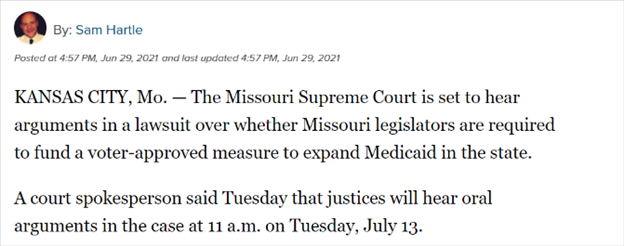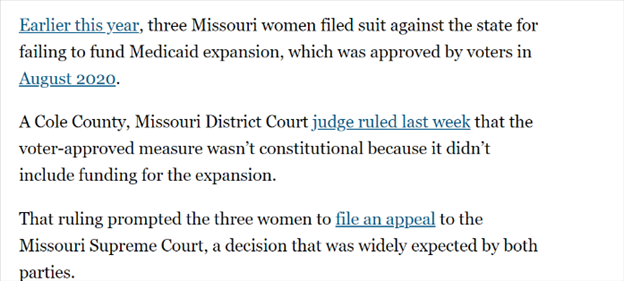MM Curator summary
After 6 years, the North Carolina managed care implementation has finally arrived.
The article below has been highlighted and summarized by our research team. It is provided here for member convenience as part of our Curator service.
Written by GARY D. ROBERTSON
After six years of preparations and delays, most of North Carolina’s Medicaid recipients switched over to managed care Thursday with its developers hopeful the changes will mean improved health outcomes and controlled costs.
“It’s been a long time coming,” said Rep. Donny Lambeth, a Forsyth County Republican who helped pass the managed care law in 2015 and other legislative adjustments, some finalized just this week.
Four statewide health plans and one multi-regional plan will now handle care for roughly 1.6 million of the nearly 2.5 million consumers covered by Medicaid — mostly poor children and older adults — as well as from another program for children in low- and middle-income families. Another smaller plan for Eastern Band of Cherokee Indians members also has started.
More Medicaid consumers, particularly those with substance abuse issues, developmental disabilities and severe mental health troubles, shift to similar managed care coverage in July 2022.
“It’s the biggest change to our program in its history,” said Health and Human Services Secretary Mandy Cohen, whose agency awarded the five-year plan contracts — expected to cost $6 billion annually — and carries out the law.
The Medicaid overhaul initially was supposed to start in 2018 or 2019. But it got delayed as Republican legislators and Democratic Gov. Roy Cooper were knotted in a budget impasse centered on whether to expand Medicaid to cover hundreds of thousands of adults through the federal Affordable Care Act. Expansion still has not happened.
As the largest state by population yet to switch to managed care, North Carolina’s foray into privatized Medicaid will be watched closely by other states and Medicaid experts. In mid-2018, almost 70% of the nation’s Medicaid enrollees were participating in managed care plans in nearly 40 states, or about 54 million people, according to Kaiser Family Foundation data. Enrollment
For decades, Medicaid has used a traditional fee-for-service process, whereby providers bill the state for each test or procedure. Now health plans will receive monthly payments for each patient enrolled. For example, health plans initially will receive on average $170 monthly for each covered child and $420 for each adult, according to Department of Health and Human Services data.
The plans’ financial gains or losses will depend on what’s left over after medical expenses and other costs. Healthier patients could mean monetary bonuses, with financial penalties possible for poorer outcomes.
Patients have signed up for a health plan — some operated by Blue Cross and Blue Shield and United Healthcare and others with less familiar names like WellCare and AmeriHealth Caritas — or have been enrolled automatically in one. Medical providers have entered into contracts with plans and consumers are being told what to expect.
“We feel very good at this point,” state Medicaid director Dave Richard said. “There will be things that don’t work anytime you have something this big, but I think we’re as prepared as possible come July 1.”
Managed care was embraced by former Republican Gov. Pat McCrory after Medicaid cost overruns in the late 2000s and early 2010s.
Initially, Medicaid spending under managed care will increase, with new administrative and underwriting expenses and more consumers still covered in the COVID-19 pandemic. Medicaid spending this coming year is projected at $18.3 billion, with 70% paid through federal funds and the rest from the state and other sources. Medical service spending is projected to decline as managed care matures.
Lambeth, a former hospital executive, is hopeful eliminating medical redundancies will curb overall costs. Keeping costs under control will require significant DHHS and legislative oversight of the health plans, said Hemi Tewarson, executive director of the National Academy for State Health Policy.
State officials must “really push them to do all the things that they should be doing or could be doing,” Tewarson said in an interview.
Tewarson said she’s anxious to see how North Carolina conducts pilot projects that will target further ways to address the non-medical needs of Medicaid patients such as homelessness, transportation and access to healthy foods.
Lambeth said he’s concerned some providers are not ready to handle the paperwork that managed care requires. Other small-town doctors or personal care agencies may not have entered contracts with multiple health plans, meaning some patients may learn they can’t use those providers.
Michelle White, a director of Cone Health’s HomeCare Providers, covering four central counties, said consumers who have been struggling during the pandemic may not realize how managed care could affect them.
“What’s going to happen July 1 and the days and the weeks to follow will be somewhat of an awakening as people start to understand that there have been changes with their Medicaid,” said White, whose agency will serve about 100 Medicaid managed care patients daily. “We’re going to have work to do as an industry to really help them get settled into the right plan, the plan that’s going to meet their needs.”
Photo via Robert Willett/The News & Observer and the Associated Press.
Clipped from: https://chapelboro.com/news/state-government/costs-watched-as-medicaid-managed-care-begins-in-n-carolina











